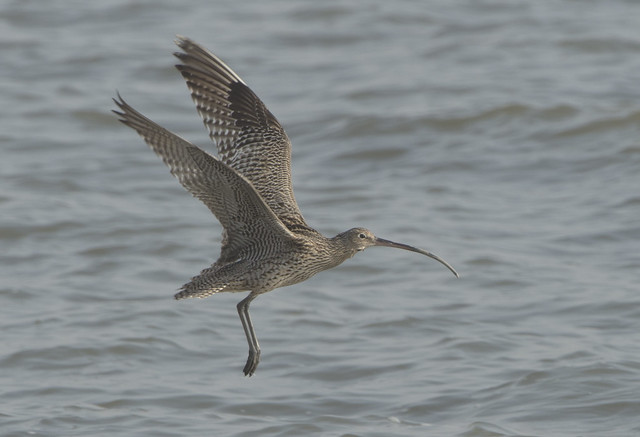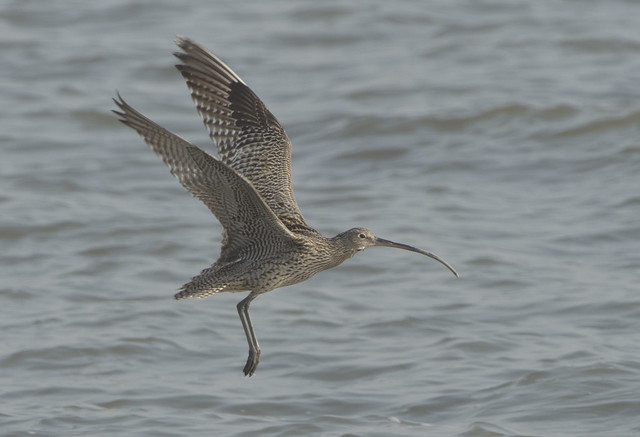Mark Carey (Chair) and Connie Warren (Coordinator)
Far Eastern Curlew Task Force
The Far Eastern Curlew Numenius madagascariensis is one of the largest shorebirds in the world. Its very large size (900 g) and very long bill (19cm) distinguishes it from other similar species in Australia and the East Asian–Australasian Flyway (Flyway). It is endemic to the Flyway, breeding in Russia and China and migrating as far as New Zealand. Declining numbers at the species’ staging and non-breeding sites prompted the Australian Government to list the species as ‘Critically Endangered’ under EPBC Act in May 2015. In large part, the observed decline in Far Eastern Curlew numbers stems from ongoing loss of intertidal mudflat habitat at key migration staging sites in the Yellow Sea. If the main threats continue, further decline or extinction is expected.

Far Eastern Curlew © Eugene Cheah/EAAFP
Acknowledging the severe decline of Far Eastern Curlew, the Australian Government initiated the development of an International Single Species Action Plan under the auspices of the East Asian–Australasian Flyway Partnership (EAAFP) with the support of Australia’s bilateral migratory bird agreement partners Japan, China and the Republic of Korea and the Convention on the Conservation of Migratory Species of Wild Animals (CMS). International Single Species Action Plans are an important instrument to promote and coordinate activities that seek to protect and restore habitat, and to mitigate obstacles to migration and other controlling factors that might endanger species. Australia also recently developed an International Single Species Action Plan for Loggerhead Turtles in the South Pacific Ocean that was unanimously endorsed by relevant Range States and CMS in November 2014.
For the past two years, all Range States, CMS Parties, EAAFP Partners, relevant non-government organisations and researchers have been actively engaged in developing the Action Plan for Far Eastern Curlew. The Action Plan was designed to outline an internationally agreed list of activities necessary along the flyway, to improve the understanding of the species’ status, to halt its decline and support its long-term survival. The Action Plan addresses key threats at important sites along the flyway, ranging from the breeding grounds, stop-over (or staging) and non-breeding sites.
The goal of the Action Plan is to return the Far Eastern Curlew to a positive population growth rate for at least three generations. Essential actions identified in the Action Plan to achieve this are to:
- Identify, protect and manage remaining sites used by the species during its annual cycle
- Reduce or eliminate illegal harvesting and incidental bycatch
- Robustly monitor the species’ population trend
- Determine key demographic parameters to support population modelling
- Constitute a Far Eastern Curlew Task Force and keep it functioning until the goal is achieved.
At the 9th Meeting of the Partners in January 2017, Australia introduced the final Far Eastern Curlew Single Species Action Plan for agreement, along with the revised Task Force Terms of Reference and an ambitious 2-year workplan. All papers were unanimously approved and Australia was re-elected as Chair of the Task Force, with BirdLife Australia elected as Task Force coordinator.
The mechanism of an International Single Species Action plan has been proven to be effective in improving and coordinating conservation efforts. The Action Plan will be coordinated by the Far Eastern Curlew Task Force established under the EAAFP and is designed to be implemented by governments and non-government bodies. The Single Species Action Plan provides an important tool for promoting and coordinating conservation at an international, national and regional level. The Action Plan provides guidance for Range States, CMS Parties, EAAFP Partners, conservationists, researchers and habitat managers over the next decade, while also providing a model for further advancing migratory bird conservation throughout the flyway.
The development of the Action Plan demonstrates Australia’s commitment to the conservation of transboundary species listed under the three migratory bird agreements and the CMS. The Far Eastern Curlew is one of 20 priority bird species identified the Australian Government’s Threatened Species Strategy and the Action Plan is an important mechanism to achieve lasting success. Australia also took the opportunity to announce the $500,000 National Environmental Science Programme Threatened Species Recovery Hub research project focusing on Far Eastern Curlew recently approved by the Australian Government Minister for the Environment and Energy.
All Range States must act quickly to halt the Far Eastern Curlew’s imminent extinction. All threats must be minimised or preferably eliminated within the next decade. International and regional cooperation is essential to prevent extinction of this migratory shorebird. The Far Eastern Curlew Task Force will continue to work intersessionally with Range States, Partners and stakeholders to facilitate implementation of the Action Plan and report on progress at the next Meeting of Partners in 2019.
Relevant links:





